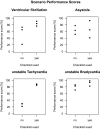A simulation-based pilot study of crisis checklists in the emergency department
- PMID: 33687692
- PMCID: PMC8563565
- DOI: 10.1007/s11739-021-02670-7
A simulation-based pilot study of crisis checklists in the emergency department
Abstract
Checklists can improve adherence to standardized procedures and minimize human error. We aimed to test if implementation of a checklist was feasible and effective in enhancing patient care in an emergency department handling internal medicine cases. We developed four critical event checklists and confronted volunteer teams with a series of four simulated emergency scenarios. In two scenarios, the teams were provided access to the crisis checklists in a randomized cross-over design. Simulated patient outcome plus statement of the underlying diagnosis defined the primary endpoint and adherence to key processes such as time to commence CPR represented the secondary endpoints. A questionnaire was used to capture participants' perception of clinical relevance and manageability of the checklists. Six teams of four volunteers completed a total of 24 crisis sequences. The primary endpoint was reached in 8 out of 12 sequences with and in 2 out of 12 sequences without a checklist (Odds ratio, 10; CI 1.11, 123.43; p = 0.03607, Fisher's exact test). Adherence to critical steps was significantly higher in all scenarios for which a checklist was available (performance score of 56.3% without checklist, 81.9% with checklist, p = 0.00284, linear regression model). All participants rated the checklist as useful and 22 of 24 participants would use the checklist in real life. Checklist use had no influence on CPR quality. The use of context-specific checklists showed a statistically significant influence on team performance and simulated patient outcome and contributed to adherence to standard clinical practices in emergency situations.
Keywords: Checklist; Emergency medicine; Resuscitation; Simulation.
© 2021. The Author(s).
Conflict of interest statement
The authors declare that they have no conflict of interest.
Figures
Comment in
-
Errare humanum est, not using the checklist diabolicum.Intern Emerg Med. 2021 Nov;16(8):2227-2229. doi: 10.1007/s11739-021-02789-7. Epub 2021 Jun 20. Intern Emerg Med. 2021. PMID: 34148180 No abstract available.
References
-
- Degani A, Wiener E. Cockpit checklists: concepts, design and use. Hum Factors. 1993;35:345–359. doi: 10.1177/001872089303500209. - DOI
-
- Gawande A. The Checklist Manifesto: How to get things right. New York: Metropolitan Books; 2009.
MeSH terms
Grants and funding
LinkOut - more resources
Full Text Sources
Other Literature Sources


